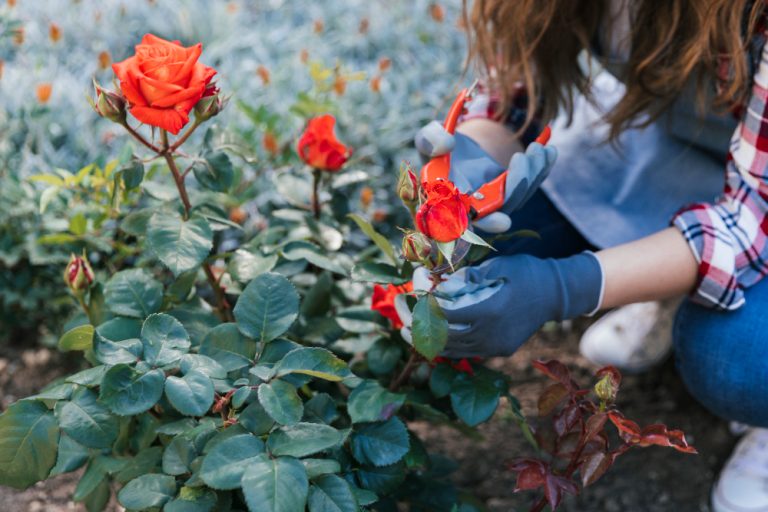
A Guide to Rose Pruning Tips for Healthy Growth
Roses are one of the most beloved and iconic flowers, cherished for their beauty, fragrance, and versatility in gardens and landscapes. However, to ensure healthy growth and abundant blooms, proper pruning is essential. Pruning helps maintain the shape of the rose bush, promotes air circulation, removes dead or diseased wood, and encourages new growth. In this comprehensive guide, we’ll explore essential tips and techniques for pruning roses to achieve optimal health and vitality.
The Basics
Before diving into the specifics of rose pruning, it’s important to understand the basics. Pruning is the process of selectively removing branches, stems, or buds from a plant to shape it, promote growth, and improve overall health. When it comes to roses, pruning serves several purposes, including:
- Stimulating Growth: Pruning encourages the production of new shoots and flowers, resulting in a fuller, more vigorous plant.
- Removing Dead or Diseased Wood: Regular pruning helps eliminate dead, damaged, or diseased branches, reducing the risk of pests and diseases spreading throughout the plant.
- Shaping and Training: Pruning allows you to control the size and shape of the rose bush, creating a more aesthetically pleasing appearance and improving air circulation within the plant.
When to Prune Roses
The timing of rose pruning depends on the specific type of rose and the climate in which it is grown. However, as a general rule of thumb, roses are typically pruned during the dormant season, which is usually in late winter or early spring. This dormant period allows the plant to recover from pruning without the risk of damaging new growth. Additionally, some types of roses, such as hybrid teas and floribundas, benefit from regular pruning throughout the growing season to encourage continuous blooming.
Essential Pruning Equipment
To effectively prune roses, you’ll need the right tools for the job. Essential pruning equipment includes:
- Pruning Shears: Also known as secateurs, pruning shears are designed for cutting small to medium-sized branches and stems. Look for sharp, high-quality shears with a comfortable grip for ease of use.
- Loppers: Loppers are larger, heavier-duty pruning tools used for cutting thicker branches and stems. They provide greater leverage and cutting power than pruning shears and are ideal for tackling larger pruning tasks.
- Gloves: A sturdy pair of gardening gloves will protect your hands from thorns, prickles, and other hazards while pruning roses. Choose gloves made from durable, puncture-resistant material for maximum protection.
Tips for Success
When pruning roses, it’s important to follow proper techniques to achieve the best results. Here are some tips for successful rose pruning:
- Start with Clean, Sharp Tools: Before you begin pruning, make sure your pruning tools are clean and sharp. Dirty or dull tools can spread disease and cause unnecessary damage to the plant.
- Remove Dead or Diseased Wood: Begin by inspecting the rose bush and removing any dead, damaged, or diseased branches. Cut back to healthy, green wood using clean, angled cuts.
- Prune for Shape and Structure: To maintain an attractive shape and promote healthy growth, prune the rose bush to remove any crossing or overcrowded branches. Aim to create an open, airy canopy that allows sunlight and air to penetrate the plant.
- Cut Above Outward-Facing Bud Eyes: When making pruning cuts, angle the cuts at a 45-degree angle and position them just above outward-facing bud eyes. This encourages new growth to grow outward, rather than inward, promoting a balanced, well-shaped plant.
- Seal Pruning Wounds: After pruning, apply a protective sealant or pruning paint to the cut surfaces to prevent disease and promote healing. Be sure to use a non-toxic, breathable sealant specifically formulated for use on plants.
Pruning for Success
In conclusion, proper pruning is essential for maintaining the health, vitality, and beauty of roses. By understanding the basics of rose pruning, selecting the right tools, and following proper techniques, you can help your roses thrive and flourish year after year. Whether you’re a seasoned gardener or a novice enthusiast, mastering the art of rose pruning will allow you to enjoy a bountiful display of blooms and create a stunning focal point in your garden or landscape. So grab your pruners, put on your gloves, and get ready to unleash the full potential of your roses with expert pruning techniques.